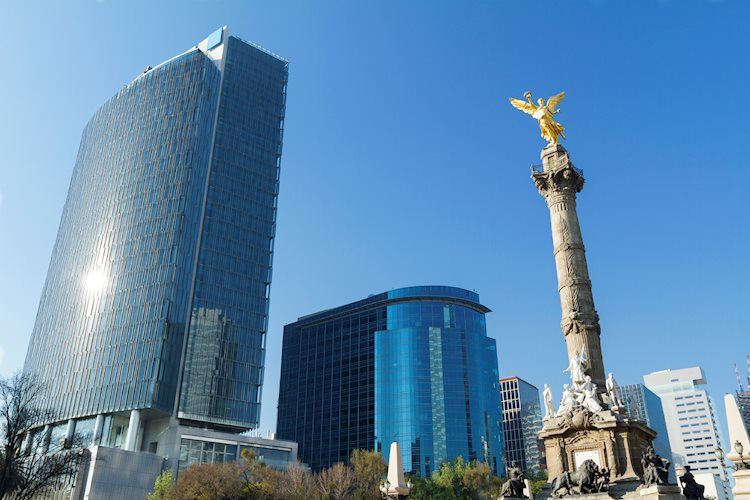Executive Summary
Brendan McKenna, Macro Strategist [email protected] ● (212) 214-5637
The Mexican economy contracted last year, the first annual contraction since the 2008-2009 financial crisis. Given the likely economic impact of COVID-19 and sharp decline in global oil prices, we now expect the economy to experience another annual contraction in 2020.
Policy choices made by the current administration towards the end of 2018 weighed on the economy in 2019, and while President Obrador did not make any overly concerning decisions last year, recent announcements led us to believe elevated political risk could once again hurt the economy.
In response to the further economic deceleration that is likely imminent, we believe the Central Bank of Mexico will need to continue easing monetary policy. The central bank has already cut policy rates; however, we believe it will need to get more aggressive with rate cuts in an effort to offset the dual shock the economy is now facing.
Going Back to Back
For the past few years, the Mexican economy has struggled to gather any significant momentum. Since experiencing an annual growth rate of 2.6% in 2015, GDP growth has been slowly deteriorating, with the economy slowing every year since. The deceleration was most evident in 2019, with the economy falling into recession and contracting on a full-year basis for the first time since the peak of the financial crisis in 2009. Over the course of the year, the economy experienced multiple quarterly contractions and registered an annual growth rate of -0.1%.
We can point to a few reasons for the sharp slowdown in the economy last year. The first being that, in our view, policy rates were too high and have been restrictive of growth for some time now. While the central bank lowered its main policy rate 100 bps over the course of 2019, the Central Bank of Mexico still maintained one of the highest policy rates in the emerging world. In addition, uncertainty surrounding the ratification of the USMCA likely led to a slowdown in cross- border trade with the U.S., while a general slowdown in U.S. industrial production likely also weighed on activity in Mexico. However, perhaps the most influential factor over the slowdown is elevated political risk associated with the administration of Andres Manuel Lopez Obrador (AMLO). Following AMLO’s decision to cancel construction of a major airport, negatively impacting both local and foreign investor capital, local Mexican businesses and foreign investors have been hesitant to deploy capital in the country, also putting pressure on the local economy.
As far as growth in 2020, we feel many of the same factors that hurt Mexico’s economy in 2019 are still present. While trade policy uncertainty has receded now that the USMCA has been formally ratified, and despite the central bank cutting interest rates a bit more aggressively this year, we still believe elevated interest rates are holding back the economy, similar to the view expressed by the IMF in its most recent Article IV assessment of the economy. Not only will these factors likely weigh on activity again this year, the economy is also likely to come under pressure from the effects of COVID-19.
While data suggesting the potential impact from the virus are still scarce, some initial indications suggest the effect of the virus will be severe. PMI data from China and the Eurozone have fallen significantly, while initial jobless claims in the United States spiked signaling U.S. unemployment may rise significantly. Deteriorating data in the United States has significant implications for Mexico given that over 80% of Mexico’s exports go to the U.S. and 45% of imports come from the United States. In addition, about 40% of Mexico’s total incoming foreign direct investment comes
ECONOMICS GROUP
from the United States, and with the uncertainty of COVID-19 lingering over the U.S. economy, it is likely that American companies will reconsider making direct investments into foreign countries, which could act as a drag on the Mexican economy.
Aside from COVID-19, tensions between Saudi Arabia and Russia over oil production are also likely to have knock-on effects for Mexico. In the aftermath of Saudi Arabia and Russia not being able to agree on a deal to cut oil production, global prices have collapsed over 65% this year. As of now, WTI crude oil is trading around $20 per barrel, and with Mexico being a significant oilproducer, oil prices at these levels should be yet another drag on Mexico’s economy. Mexico’s oil production primarily comes from its state-owned energy company, Pemex. Pemex facilities have been deteriorating for some time now, with oil production on a downward trajectory for over 15 years. As of February 2020 oil production was just 1.75 million barrels per day, down from close to three million barrels per day in 2004, and has Pemex’s credit rating on the verge of being downgraded to junk status by S&P. The combination of sharply lower oil prices and declining production will likely decrease oil related revenue for the government and also contribute to aslowdown in Mexico’s economy.
Looking ahead, we feel the combination of an already fragile economy, likely to be impacted further by the effects of COVID-19 and lower oil prices means Mexico’s economy is headed for an extended recession and even deeper contraction. As of now, we believe GDP will contract around 5% this year.


